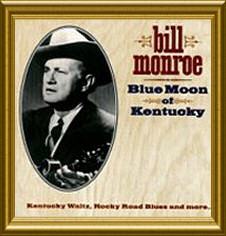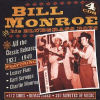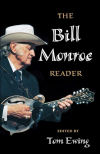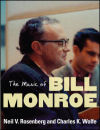
HOME
INTRO
SYMBOLS
ALMANAC
ECONOMY
GEOGRAPHY
STATE MAPS
PEOPLE
FORUM
NEWS
COOL SCHOOLS
STATE QUIZ
STATE LINKS
BOOK STORE
MARKETPLACE
NETSTATE.STORE
NETSTATE.MALL
GUESTBOOK
CONTACT US


Tweet
Double click on word for definition.
Kentucky State Bluegrass Song
Blue Moon of Kentucky
words and music by William Smith "Bill" Monroe
Blue moon of Kentucky, keep on shining, Shine on the one that's gone and proved untrue; Blue moon of Kentucky, keep on shining, Shine on the one that's gone and left me blue. It was on a moonlight night, the stars were shining bright; And they whispered from on high, your love had said goodbye. Blue moon of Kentucky, keep on shining, Shine on the one that's gone and said goodbye.
About William Smith "Bill" Monroe

In 1911, William Smith Monroe, a descendent of President James Monroe, was born near Rosine, Kentucky. Music was natural to William Smith Monroe. He grew up singing on the front porch with his family. By the time he was 12, he was an eager guitar player. Between 1928 and 1930, William Smith and his brothers, Charlie and Birch, formed their own band, the Monroe Brothers. William was picked to play the mandolin because the other brothers didn't know how to play it and William, well...he was the youngest.
In 1938, the Monroe Brothers broke up and William formed the Kentuckians, which evolved into The Blue Grass Boys. Monroe's new musical directions included driving rhythms and tight harmonies. His music was a combination of Appalachian, Church, Jazz and Breakdown styles. This was the beginning of bluegrass.
From 1939-1941, Bill Monroe and The Bluegrass Boys performed at the Grand Ole Opry, were signed by RCA Records and formed their own touring company.
In 1946 Bill Monroe wrote and The Bluegrass Boys first recorded a song that was to become Monroe's signature, "Blue Moon of Kentucky."
By 1970, Bill Monroe was widely recognized as the "Father of Bluegrass." And in that year, he was inducted into the Country Music Hall of Fame, the next year into the Nashville Songwriters Association International Hall of Fame and more was to come...
- Formed the Bean Blossom Festival
- Opened Bluegrass Hall of Fame in Nashville
- Inducted into the Bluegrass Hall of Honor
- Grammy Lifetime Achievement Award
- National Medal of the Arts
- "Blue Moon of Kentucky" Official Bluegrass Song of Kentucky
1986 - US Senate passed a resolution honoring "his many contributions to American culture and his many ways of helping American people enjoy themselves." The resolution went on to say, "As a musician, showman, composer, and teacher, Mr. Monroe has been a cultural figure and force of signal importance in our time."
Congressional Record for August 9, 1986
pp. 20406-7SENATE RESOLUTION NO. 463
A resolution to recognize and honor William Smith "Bill" Monroe, the father of bluegrass music, on his seventy-fifth birthday.
Whereas September 13, 1986 is the seventy-five birthday of the father of bluegrass music, William Smith "Bill" Monroe:
Whereas Mr. Monroe has been an innovator, creator, shaper, performer and promoter of a genre in music which was developed in a particular region of the United States, the upper South;
Whereas Mr. Monroe's music is national in scope, is a part of American culture and is now being shared internationally;
Whereas since 1938, Mr. Monroe and his "Blue Grass Boys", a band that has served as a training ground for most of the leading musicians in bluegrass music, have provided entertainment and sustenance to Americans from all walks of life;
Whereas Mr. Monroe has been a member of the Grand Ole Opry since 1939, a member of the Country Music Hall of Fame since 1969, and has gone from pioneer to patriarch of this popular and important style of American music; and
Whereas as a musician, showman, composer, and teacher, Mr. Monroe has become a cultural figure and force of signal importance in our time; Now, therefore, be it
Resolved, That the United States Senate recognizes and honors William Smith "Bill" Monroe for his many contributions to American culture and music, and his many years of helping the American people to enjoy themselves, and extends its best wishes to "Bill" Monroe on the occasion of his seventy-fifth birthday.
Before Bill Monroe, there was no bluegrass music. It is no wonder that Bill Monroe's "Blue Moon of Kentucky" was adopted as the official bluegrass song of Kentucky in 1988.
When asked about the story behind the writing of "Blue Moon Over Kentucky," Bill Monroe said
Back in those days, it seems every trip we made was from Kentucky to Florida, driving back and forth. I always thought about Kentucky, and I wanted to write a song about the moon we could always see over it. The best way to do this was to bring a girl into the song. I wanted words to this because most of my songs were instrumentals. “Kentucky Waltz” had come earlier and I knew I could write both words and music, so I wrote it in the car on the way home from one of those Florida trips.
Bill Monroe died from a stroke on September 9, 1996, in Springfield, Tennessee.
Kentucky Law
The following information was excerpted from the Kentucky Statutes, Title 99, Chapter 99, Section 99.
TITLE I - SOVEREIGNTY AND JURISDICTION OF THE COMMONWEALTH
CHAPTER 002. CITIZENSHIP, EMBLEMS, HOLIDAYS, AND TIME
SECTION 2.100. STATE SONG -- BLUEGRASS SONG
2.100 State song -- Bluegrass song.
(1) The song, "My Old Kentucky Home," by Stephen Collins Foster, is the official state song of Kentucky.
(2) The song, "Blue Moon of Kentucky" by Bill Monroe, is the bluegrass song of Kentucky.
Effective: July 15, 1988
History: Amended 1988 Ky. Acts ch. 134, sec. 1, effective July 15, 1988. -- Recodified 1942 Ky. Acts ch. 208, sec. 1, effective October 1, 1942, from Ky. Stat. sec. 4618p.
Legislative Research Commission Note. The modern version of "My Old Kentucky Home" was adopted during the 1986 Regular Session of the General Assembly by the House of Representatives in House Resolution 159 and the Senate in Senate Resolution 114. This version substitutes the word "people" for the word "darkies."
Sources...
O'Dell, Cary, and Matt Barton. "“Blue Moon of Kentucky” — Bill Monroe and the Blue Grass Boys (1947)." National Recording Preservation Board. Library of Congress, 14 July 2014. Web. 10 Mar. 2015.
Kentucky Department of Libraries & Archives, (http://www.kdla.ky.gov), December 10, 2004.
Kentucky Legislature, (http://www.lrc.ky.gov/), December 10, 2004.
Shankle, George Earlie. State Names, Flags, Seals, Songs, Birds, Flowers, and Other Symbols. Irvine, Calif.: Reprint Services Corp, Revised edition, 1971.
Shearer, Benjamin F. and Barbara S. State Names, Seals, Flags and Symbols: A Historical Guide Third Edition, Revised and Expanded. Westport, Conn: Greenwood Press, 3 Sub edition, 2001.
Additional Information
"Blue Moon of Kentucky": From Wikipedia, the free encyclopedia.
“Blue Moon of Kentucky” Bill Monroe and the Blue Grass Boys (1947) :
Library of Congress: National Recording Preservation Board: National Recrodign Registry: 2002 - Essay by Cary O’Dell, with Matt Barton.
:
Library of Congress: National Recording Preservation Board: National Recrodign Registry: 2002 - Essay by Cary O’Dell, with Matt Barton.
Bill Monroe: Country Music Hall of Fame in Nashville, Tennessee.
Bill Monroe: Bill Monroe artist page: interviews, features and/or performances archived at National Public Radio (NPR) Music.
Bill Monroe: Website of the Internation Bluegrass Music Museum: Bluegrass Hall of Fame, called Hall of Honor, 1991 inductee.
Bill MOnroe: From Wikipedia, the free encyclopedia.
Bill Monroe: 1997 Rock and Roll Hall of Fame inductee for his influence on rock and roll music.
Bill Monroe Music Park & Campground: Website of the Bill Monroe Music Park & Campground, Morgantown, Indiana, and home to the annual Bill Monroe Bean Blossom Bluegrass Festival.
State songs: Complete list of official state songs from NETSTATE.COM
More symbols & emblems: Complete list of official Kentucky state symbols from NETSTATE.COM.

All the Classics 1937-1949
Bill Monroe and
His Bluegrass Boys
Bill Monroe and His Bluegrass Boys: All the Classics 1937-1949
Label: Jsp Records Audio CD (June 10, 2003) Original recording remastered
Run Time: 307 minutes Format: Box set Number of Discs: 4.
All the Classic Releases 1937-1949 album for sale by Bill Monroe was released Jun 10, 2003 on the JSP label. & His Bluegrass Boys. All the Classic Releases 1937-1949 CD music is a 4-disc set with 112 songs.
Personnel: Bill Monroe (vocals, guitar, mandolin); Clyde Moody (vocals, guitar, mandolin); Tex Willis, Lester Flatt, Mac Wiseman, Charlie Monroe (vocals, guitar); Earl Scruggs (vocals, banjo); Tommy Magness (vocals, fiddle); Bill Wesbrooks, Birch Monroe (vocals); David Akeman, Rudy Lyle (banjo); Robert Chubby Wise (fiddle); Wilene Forrester (accordion).

Can't You Hear
Me Callin'
Richard D. Smith
Can't You Hear Me Callin': The Life of Bill Monroe, Father of Bluegrass, by Richard D. Smith. 384 pages. Publisher: Little, Brown and Company; First Edition edition (July 1, 2000)
Compellingly narrated and thoroughly researched, this text is the definitive biography of a true giant of American music, Bill Monroe.
Considering the range of stars that have claimed Bill Monroe as an influence-Elvis Presley, Bob Dylan, and Jerry Garcia are just a few-it can be said that no single artist has had as broad an impact on American popular music as he did. For sixty years, Monroe was a star at the Grand Ole Opry, and when he died in 1996, he was universally hailed as "the Father of Bluegrass." But the personal life of this taciturn figure remained largely unknown. Delving into everything from Monroe's professional successes to his bitter rivalries, veteran bluegrass journalist Richard D. Smith has created a three-dimensional portrait of this brilliant, complex, and contradictory man. Featuring over 120 interviews, this scrupulously researched work-a Chicago Tribune Choice Selection, New York Times Notable Book, and Los Angeles Times Best Book of 2000-stands as the authoritative biography of a true giant of American music.

The Bill Monroe Reader
Tom Ewing
The Bill Monroe Reader, by Tom Ewing. 336 pages. Publisher: University of Illinois Press (February 27, 2006)
The Bill Monroe Reader traces the career of the “Father of Bluegrass Music” who transformed a local musical style into a unique national music form.
In this eclectic, richly illustrated reader, former Blue Grass Boy Tom Ewing gathers the most significant and illuminating of the many articles that have been written about Monroe. Through the writings of nearly sixty observers, interviewers, admirers, folklorists, and other scholars, along with Ewing's astute commentary, The Bill Monroe Reader offers a multifaceted view of one of the most influential country musicians of the twentieth century.
Determined to play the mandolin in a way it had never been played before, Monroe distinguished himself in the mid-1930s with the Monroe Brothers, then began forming his own band, the Blue Grass Boys, in 1938. By the mid-1940s other bands were copying his sound, and a new style, bluegrass music, was born. While country music moved toward electrification, Monroe maintained his acoustic ensemble and developed his "high, lonesome sound," performing nearly up to his death in 1996.

The Music of Bill Monroe
Neil V. Rosenberg
Charles K. Wolfe
The Music of Bill Monroe, by Neil V. Rosenberg and Charles K. Wolfe. 384 pages. Publisher: University of Illinois Press; 1 edition (June 7, 2007)
The definitive study of Bill Monroe’s contributions to American and world music.
Spanning over 1,000 separate performances, The Music of Bill Monroe presents a complete chronological list of all of Bill Monroe’s commercially released sound and visual recordings. Each chapter begins with a narrative describing Monroe’s life and career at that point, bringing in producers, sidemen, and others as they become part of the story. The narratives read like a "who's who" of bluegrass, connecting Monroe to the music's larger history and containing many fascinating stories.
The second part of each chapter presents the discography. Information here includes the session’s place, date, time, and producer; master/matrix numbers, song/tune titles, composer credits, personnel, instruments, and vocals; and catalog/release numbers and reissue data. The only complete bio-discography of this American musical icon, The Music of Bill Monroe is the starting point for any study of Monroe's contributions as a composer, interpreter, and performer.

